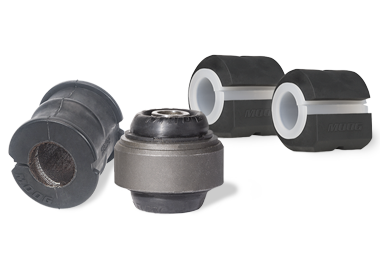Bushings are rubber or polyurethane cushions that absorb vibrations between metal parts in your suspension system, allowing movement while reducing noise and friction. Without them, every bump would feel brutal and metal parts would wear out quickly.
When I inspect vehicles at our factory, I see how bushings silently protect other components. They’re like shock absorbers for smaller movements. Let me explain why they matter so much.

What Is the Purpose of a Bushing?
Ever wondered why your car doesn’t rattle apart on rough roads? Bushings are the hidden heroes. They work constantly but get little attention until they fail.
The main purpose of a bushing is to separate metal suspension components while allowing controlled movement, reducing noise, vibration, and harshness (NVH) in the vehicle. This extends the life of other parts.
In our 25 years of manufacturing(GSW Autoparts), we’ve seen how bushings protect whole systems:
- Control Arms: The bushings here handle vertical wheel movement
- Stabilizer Bars: Bushings allow the bar to twist while preventing metal-on-metal contact
- Engine Mounts: These heavy-duty bushings absorb engine vibrations
Without bushings, a Toyota Hilux would shake like an old tractor. Modern cars like the Ford Ranger rely on precise bushing designs for their smooth ride quality.
Why Use a Bushing Instead of a Bearing?
You might think bearings would work better since they spin freely. But suspension systems need something different. Bushings outperform bearings for many automotive applications.
Bushings are used instead of bearings where vibration absorption and controlled flexibility matter more than free rotation, like in suspension joints that need to twist slightly while damping impacts.
Here’s why we specify bushings for most suspension applications:
| Feature | Bushing | Bearing |
|---|---|---|
| Vibration Damping | Excellent | Poor |
| Cost | Lower | Higher |
| Maintenance | Minimal | Requires lubrication |
| Angular Movement | Good | Limited |
For example, the Volkswagen Golf uses bushings in its front control arms because they better handle the twisting forces during cornering. A bearing would wear out quickly in this application.
How Do Bushings Reduce Friction?
The science behind bushing operation is fascinating. They don’t eliminate friction – they manage it intelligently through material science and design.
Bushings reduce friction through their elastic materials (like rubber or polyurethane) that deform slightly under load, spreading forces over a larger area while preventing direct metal contact.
At our factory, we test bushing materials extensively:
- Natural Rubber: Best for comfort but wears faster
- Polyurethane: More durable but firmer ride
- Fluid-Filled: Used in luxury cars like Mercedes-Benz for ultra-smooth damping
The Nissan Navara uses special compound bushings that balance off-road durability with on-road comfort. We supply these to dealerships worldwide.
Can I Drive With Bad Bushings?
You might be tempted to postpone bushing replacement. But damaged bushings cause cascading problems that get expensive fast.
Driving with bad bushings risks damage to other suspension components, causes poor handling, and creates safety hazards as control deteriorates – replacement is strongly recommended for any cracked, torn, or missing bushings.
Here’s what happens when bushings fail in popular models:
- Toyota HiAce: Worn bushings cause wandering steering
- Isuzu D-Max: Failed bushings lead to uneven tire wear
- Mitsubishi Pajero: Bad bushings make the suspension noisy
We advise checking bushings every 50,000 km. Our replacement kits make this maintenance easy for mechanics.
Conclusion
Bushings quietly make modern vehicles comfortable and safe. Understanding their function helps maintain your car properly and avoid costly repairs.